| Reviews & Columns |
|
Reviews DVD TV on DVD Blu-ray 4K UHD International DVDs In Theaters Reviews by Studio Video Games Features Collector Series DVDs Easter Egg Database Interviews DVD Talk Radio Feature Articles Columns Anime Talk DVD Savant Horror DVDs The M.O.D. Squad Art House HD Talk Silent DVD
|
DVD Talk Forum |
|
|
| Resources |
|
DVD Price Search Customer Service #'s RCE Info Links |
|
Columns
|
|
|
Goya's Ghosts
Sony Pictures // R // February 26, 2008
List Price: $24.96 [Buy now and save at Amazon]
Milos Forman's One Flew Over The Cuckoo's Nest illustrates some of the starkest analyses on insanity and bureaucratic control on film; conversely, Amadeus slams home the quintessence of "period piece" with astounding vigor. You'd think that when he steps up to the plate to combine the two in his latest work, Goya's Ghosts, that he'd bring everything fluid about his experience into one powerhouse of a film. He brought thoughtful perception and compellingly dark humor to the plate with some bizarrely entrenching performances, but Forman's latest film about the mangled perceptions of the church during the period of the Inquisition can't make up its mind about how to portray itself. In effect, Goya's Ghosts becomes a misrepresented, un-cohesive cluster of mildly intriguing themes that breathes with enough of a historically riveting breath to keep the characters interesting.
The Film:
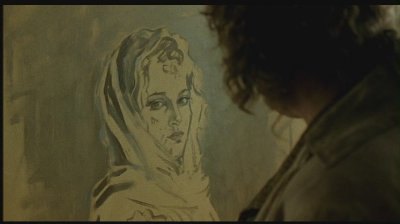
Set in the late 1700's during the Spanish Inquisition, Goya's Ghosts follows the tumultuous pathway of Ines (Natalie Portman), a young daughter to a wealthy merchant that becomes under fire from the Church. Amidst a condemning meeting between several key Church members, Brother Lorenzo (Javier Bardem) attempts to defend the religiously aggressive artwork of one Francisco Goya (Stellan Skarsgard). Ines is one of Goya's models, his muse even, as she influences works that range from simple portraits to the faces of radiant depictions of angels sprawled across ceilings. In response, the Church takes the simple matter of Ines refusing pork at a well-monitored meal as a sign of Jewish allegiance. She is then arrested and put to "The Question" - a barbaric analogue that represents torturous interrogations.
Javier Bardem's obscure and controlled front as brother Lorenzo offers a strangely captivating element in Goya's Ghosts. As the slimy, unsettling priest, he commands more interest than either the harlot under trial or the captivating artists responsible for the artwork. Portman and Skarsgard both perform their respective roles diligently at this point, but Bardem's discomforting glances seems so effortlessly entrancing that they slowly become our focus. Notably strong in his other role around this time, as the diabolical killer in No Country for Old Men, Bardem really strut his versatility in this role as well.
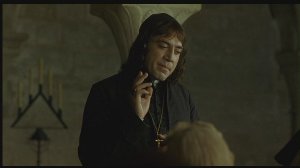
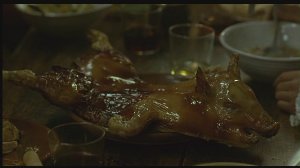
Goya's Ghosts, a film that simplifies its key players as heretics, harlots, artists, royalty, or men of the cloth, initially becomes both a humdrum condemnation of medieval religious practices and a thick meditation on human fragility. It plays with the weakened nature of confession under pressure, but in a way that utilizes its interesting characters moderately well. Much of the strength from this element resides in Jose Luis Gomez's performance as Ines father, Tomas. The way he confronts Lorenzo at their pivotal conjuncture in Goya's Ghosts tinkers with human nature in a formidable way. Mentalities crack left and right in Forman's film, as is to be expected from a director that can make both nurse and patient in a mental institution seem both scathingly human and completely bonkers.
Forman's focus on crumbling sanity barely skims over the explanation of each character's fate in Goya's Ghosts, instead opting to gap the two halves of the film into solid cause / effect portions without much connective tissue between the joints. His film is, in essence, two separate narratives connected by one dramatic remnant bridging across a fifteen-year gap to more unsatisfying themes. Unfortunately, all remnants of solidity and pensiveness here fade once this gap is crossed. Instead, Goya's Ghosts fumbles with the mangled sanity of a falsely imprisoned woman released into the chaos of a revolution. Everything transforms over this timeframe, including Goya's capacity to hear the world around him. Strangely, though the film features the artist as the catalyst of the chaos, Skarsgard's Goya really gets ushered aside as more of a liaison between the characters than much of his own entity. It's a shame, because Skarsgard instills plenty of cordiality and cheerfulness to the artist that would make him a compelling character amidst this historical imagination.
Aesthetically, Goya's Ghosts is a peculiarly alluring film. Forman opts for a palette drenched with earthy tones, namely olives and tans. This adds an intriguing effect to stark colors that wiggle into the picture, such as the red trim in the priests' clothing; it makes them look dirty, tainted even. Since Goya's Ghosts is, in effect, a "tainted" film about the tarnished quality of the Church, it helps to convey Forman's desired flavor. With the help of some fine costume work, along with set design, the film's aged and shackled attitude sees daylight amidst a dark persona. Bizarrely, amidst the worn visage it ensnares, it delves into an intriguingly handsome persona. Even the film's secondary beauty, Portman's Ines, becomes soiled throughout the film. Natalie Portman stretches herself across several personas, each with their own personality that fluctuates from transformation to slight tinkering. Portman molds around them both visually and thematically, one as the weathered Ines to a much more realized level than the others.
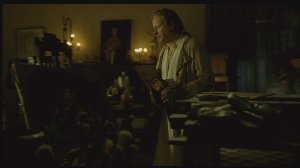
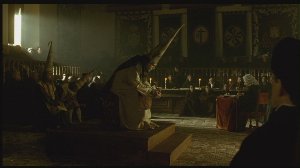
Once Ines' conflict withers into the wispy Spanish air and Goya's Ghosts approaches the flipside of the fifteen-year detainment, Forman's film crumbles into its own oddity as the French influence sprawls into its settings. Inspired performances, especially from the effervescent, transforming Bardem, keep interest mildly piqued; Goya's Ghosts becomes so contrived and considerably peculiar in its periodic attitude, though, that their efforts stand out like scepters in thickened mud. It becomes a rambling exercise in historical schmaltz that sporadically concentrates on several plights of mankind, sputtering and slaving away to try and hold audience curiosity. As the narrative wears out its welcome, the illuminating portrayals from the actors in Goya's Ghosts still keep interest long enough to stick with Forman's film to its odd finale.
The strongest points in Goya's Ghosts revolve around the artist's work, how it's conceived, and how it influences the surrounding Spanish world. As painter to the royal family and as an engraver with his more taut, affective pieces, Goya's creativity becomes a character all its own at the start of the film. Watching Goya assemble one of his etchings guides this perception, as he must intricately scroll the image in reverse onto a metal plate to be pressed. It almost makes it look like Goya is merely harnessing the image in his hand, doing the bidding of another force as he crafts one of his religious critiques. That can be said for many artists, most even. At times, their artform might seem like an extension of themselves, while at other moments they might seem like separate entities that live and breathe on their own. Goya's work harnesses this essence, which can be felt across the entirety of Goya's Ghosts. Unfortunately, much of Forman's cinematic artistry can be seen, but not felt, inside this latest addition to his work.
The DVD:

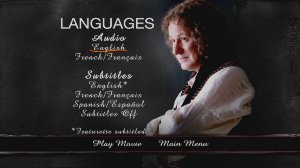
Sony presents Goya's Ghosts in a standard keepcase presentation with replicated artwork on both the cover and disc itself.
The Video:
As mentioned before, Goya's Ghosts renders a very dirty, dusty 1.85:1 widescreen image. Sony's anamorphic presentation delivers the coloring and aged essence properly, yet leaves a bit to be desired regarding detail and solidity of colors. At the start, the image feels a shade on both the flat and dark side. Several minor details, like buttons on coats, numerous brush strokes, and debris upon Portman's face whilst imprisoned, display an ample level of detail. However, these details see a bit of blur at times with other elements. What becomes really surprising is the inconsistency of color in any open-aired, outdoor scenes in the film. The skies struggle to fight off digitization, rendering a bit of the "gnat" look. Overall, the costumes and works of art all look sharp, but the level of detail and dimensionality of the image could've been a bit better.
The Audio:
Equally as mediocre is the English Dolby 5.1 track. Vocal strength stays predominately strong, though a great deal of the activity stays at the front. The brusque musical accompaniment chimes in a bit loud at times, but that reflects a bit of the interruptive and peculiar tone to the film. Digital defects and / or burps in the track, however, didn't really come about. It serves the purpose admirably. A French 5.1 track is also available, as are optional English, French, and Spanish subtitles.
The Extras:
After flipping the disc over several times, dusting off both sides and searching every nook and cranny, I could find but one, single supplemental feature:
Behind-the-Scenes Featurette:
I'm not sure exactly what Sony wants us to do with a featurette that lasts a hair over 2 minutes, but by golly we've got to milk it for all its worth since it's the only thing included. Tidbits from Forman, Portman, Bardem, and other producers and crew find their way into this short piece that surmounts to nothing much more than a brief TV spot.
-----
Final Thoughts:
Goya's Ghosts exhibits a chunk of the artistry that director Milos Forman has brought his other worldly and analytical films, yet it lacks the cohesiveness in theme and narrative to support its intriguing performances and historical essence. Portman, Skarsgard, and especially Bardem bring their acting chops to the table even when the waning theatrics grind on the nerves. In this DVD presentation, Goya's Ghosts looks and sounds moderately stable, while the extra material barely works up a slight sweat in trying to provide interest in its invested audience. Overall, Goya's Ghosts is a film with enough compelling performances and intriguing ideas in the first half of the film to be worth a Rental.
Thomas Spurlin, Staff Reviewer -- DVDTalk Reviews | Personal Blog/Site
The Film:

Set in the late 1700's during the Spanish Inquisition, Goya's Ghosts follows the tumultuous pathway of Ines (Natalie Portman), a young daughter to a wealthy merchant that becomes under fire from the Church. Amidst a condemning meeting between several key Church members, Brother Lorenzo (Javier Bardem) attempts to defend the religiously aggressive artwork of one Francisco Goya (Stellan Skarsgard). Ines is one of Goya's models, his muse even, as she influences works that range from simple portraits to the faces of radiant depictions of angels sprawled across ceilings. In response, the Church takes the simple matter of Ines refusing pork at a well-monitored meal as a sign of Jewish allegiance. She is then arrested and put to "The Question" - a barbaric analogue that represents torturous interrogations.
Javier Bardem's obscure and controlled front as brother Lorenzo offers a strangely captivating element in Goya's Ghosts. As the slimy, unsettling priest, he commands more interest than either the harlot under trial or the captivating artists responsible for the artwork. Portman and Skarsgard both perform their respective roles diligently at this point, but Bardem's discomforting glances seems so effortlessly entrancing that they slowly become our focus. Notably strong in his other role around this time, as the diabolical killer in No Country for Old Men, Bardem really strut his versatility in this role as well.


Goya's Ghosts, a film that simplifies its key players as heretics, harlots, artists, royalty, or men of the cloth, initially becomes both a humdrum condemnation of medieval religious practices and a thick meditation on human fragility. It plays with the weakened nature of confession under pressure, but in a way that utilizes its interesting characters moderately well. Much of the strength from this element resides in Jose Luis Gomez's performance as Ines father, Tomas. The way he confronts Lorenzo at their pivotal conjuncture in Goya's Ghosts tinkers with human nature in a formidable way. Mentalities crack left and right in Forman's film, as is to be expected from a director that can make both nurse and patient in a mental institution seem both scathingly human and completely bonkers.
Forman's focus on crumbling sanity barely skims over the explanation of each character's fate in Goya's Ghosts, instead opting to gap the two halves of the film into solid cause / effect portions without much connective tissue between the joints. His film is, in essence, two separate narratives connected by one dramatic remnant bridging across a fifteen-year gap to more unsatisfying themes. Unfortunately, all remnants of solidity and pensiveness here fade once this gap is crossed. Instead, Goya's Ghosts fumbles with the mangled sanity of a falsely imprisoned woman released into the chaos of a revolution. Everything transforms over this timeframe, including Goya's capacity to hear the world around him. Strangely, though the film features the artist as the catalyst of the chaos, Skarsgard's Goya really gets ushered aside as more of a liaison between the characters than much of his own entity. It's a shame, because Skarsgard instills plenty of cordiality and cheerfulness to the artist that would make him a compelling character amidst this historical imagination.
Aesthetically, Goya's Ghosts is a peculiarly alluring film. Forman opts for a palette drenched with earthy tones, namely olives and tans. This adds an intriguing effect to stark colors that wiggle into the picture, such as the red trim in the priests' clothing; it makes them look dirty, tainted even. Since Goya's Ghosts is, in effect, a "tainted" film about the tarnished quality of the Church, it helps to convey Forman's desired flavor. With the help of some fine costume work, along with set design, the film's aged and shackled attitude sees daylight amidst a dark persona. Bizarrely, amidst the worn visage it ensnares, it delves into an intriguingly handsome persona. Even the film's secondary beauty, Portman's Ines, becomes soiled throughout the film. Natalie Portman stretches herself across several personas, each with their own personality that fluctuates from transformation to slight tinkering. Portman molds around them both visually and thematically, one as the weathered Ines to a much more realized level than the others.


Once Ines' conflict withers into the wispy Spanish air and Goya's Ghosts approaches the flipside of the fifteen-year detainment, Forman's film crumbles into its own oddity as the French influence sprawls into its settings. Inspired performances, especially from the effervescent, transforming Bardem, keep interest mildly piqued; Goya's Ghosts becomes so contrived and considerably peculiar in its periodic attitude, though, that their efforts stand out like scepters in thickened mud. It becomes a rambling exercise in historical schmaltz that sporadically concentrates on several plights of mankind, sputtering and slaving away to try and hold audience curiosity. As the narrative wears out its welcome, the illuminating portrayals from the actors in Goya's Ghosts still keep interest long enough to stick with Forman's film to its odd finale.
The strongest points in Goya's Ghosts revolve around the artist's work, how it's conceived, and how it influences the surrounding Spanish world. As painter to the royal family and as an engraver with his more taut, affective pieces, Goya's creativity becomes a character all its own at the start of the film. Watching Goya assemble one of his etchings guides this perception, as he must intricately scroll the image in reverse onto a metal plate to be pressed. It almost makes it look like Goya is merely harnessing the image in his hand, doing the bidding of another force as he crafts one of his religious critiques. That can be said for many artists, most even. At times, their artform might seem like an extension of themselves, while at other moments they might seem like separate entities that live and breathe on their own. Goya's work harnesses this essence, which can be felt across the entirety of Goya's Ghosts. Unfortunately, much of Forman's cinematic artistry can be seen, but not felt, inside this latest addition to his work.
The DVD:


Sony presents Goya's Ghosts in a standard keepcase presentation with replicated artwork on both the cover and disc itself.
The Video:
As mentioned before, Goya's Ghosts renders a very dirty, dusty 1.85:1 widescreen image. Sony's anamorphic presentation delivers the coloring and aged essence properly, yet leaves a bit to be desired regarding detail and solidity of colors. At the start, the image feels a shade on both the flat and dark side. Several minor details, like buttons on coats, numerous brush strokes, and debris upon Portman's face whilst imprisoned, display an ample level of detail. However, these details see a bit of blur at times with other elements. What becomes really surprising is the inconsistency of color in any open-aired, outdoor scenes in the film. The skies struggle to fight off digitization, rendering a bit of the "gnat" look. Overall, the costumes and works of art all look sharp, but the level of detail and dimensionality of the image could've been a bit better.
The Audio:
Equally as mediocre is the English Dolby 5.1 track. Vocal strength stays predominately strong, though a great deal of the activity stays at the front. The brusque musical accompaniment chimes in a bit loud at times, but that reflects a bit of the interruptive and peculiar tone to the film. Digital defects and / or burps in the track, however, didn't really come about. It serves the purpose admirably. A French 5.1 track is also available, as are optional English, French, and Spanish subtitles.
The Extras:
After flipping the disc over several times, dusting off both sides and searching every nook and cranny, I could find but one, single supplemental feature:
Behind-the-Scenes Featurette:
I'm not sure exactly what Sony wants us to do with a featurette that lasts a hair over 2 minutes, but by golly we've got to milk it for all its worth since it's the only thing included. Tidbits from Forman, Portman, Bardem, and other producers and crew find their way into this short piece that surmounts to nothing much more than a brief TV spot.
-----
Final Thoughts:
Goya's Ghosts exhibits a chunk of the artistry that director Milos Forman has brought his other worldly and analytical films, yet it lacks the cohesiveness in theme and narrative to support its intriguing performances and historical essence. Portman, Skarsgard, and especially Bardem bring their acting chops to the table even when the waning theatrics grind on the nerves. In this DVD presentation, Goya's Ghosts looks and sounds moderately stable, while the extra material barely works up a slight sweat in trying to provide interest in its invested audience. Overall, Goya's Ghosts is a film with enough compelling performances and intriguing ideas in the first half of the film to be worth a Rental.
|
| Popular Reviews |
| Sponsored Links |
|
|
| Sponsored Links |
|
|
| Release List | Reviews | Shop | Newsletter | Forum | DVD Giveaways | Blu-Ray | Advertise |
|
Copyright 2024 DVDTalk.com All Rights Reserved. Legal Info, Privacy Policy, Terms of Use,
Manage Preferences,
Your Privacy Choices | |||||||














